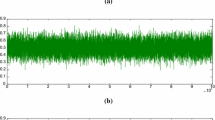Abstract
Active users have appeared who require the solution of inverse problems on a graph with conditions of uncertainty for modeling processes in the economic sphere. Such tasks were not considered by mathematicians earlier. This article provides an analogy with mathematical models which are described by a replicator system (RS) of equations related to the stated theme. The exact and asymptotic solutions are developed in the case of “stiff” RS equations. The effects of an a priori dying clone and of the boundary layer for small values of time are found. An analogy is drawn with some objects having similar features, which really exist in the economy. The effect of the existence of shadow, invisible super-consumers is described.




Similar content being viewed by others
Notes
We talked with skeptics but we found out that they do not drink water from the water supply, they avoid the consumption of palm oil and other factors that lead to the pollution of their blood vessels, etc.
REFERENCES
Í. Haken, Information and Self-Organization. A Macroscopic Approach to Complex Systems, Theoretical, Mathematical and Computer Physics (Springer, Berlin, 2005).
I. V. Andrianov, R. G. Barantsev, and L. I. Manevich, Asymptotic Mathematics and Synergetics (Editorial URSS, Moscow, 2004) [in Russian].
M. Eigen and P. Schuster, “The hypercycle. A principle of natural self-organization. Part: Emergence of the hypercycle,” Naturwissensch. 64, 541–565 (1977).
N. Lehman, N. Vaidya, and M. L. Manapat, “Spontaneous network formation among cooperative RNA replications,” Nature (London, U.K.) 491 (7422), 72 (2012).
A. S. Bratus, A. S. Novozhilov, and A. P. Platonov, Dynamical Systems and Models in Biology (Fizmatlit, Moscow, 2010) [in Russian]; A. S. Bratus and A. S. Novozhilov, “A note on the replicator equation with explicit space and global regulation,” Math. Biosci. Eng. 8 (3) (2011).
J. Hofbauer and K. Sigmund, Evolutionary Games and Population Dynamics (Cambridge Univ. Press, Cambridge, 1998).
W. Jansen, “A permanence theorem for replicator and Lotka-Volterra systems,” Math. Biol. 25, 411–427 (1987).
A. K. Volosova, “Mathematical modeling of nonlinear dynamics of an open hypercycle system,” Extended Abstract of Cand. Sci. (Phys. Math.) Dissertation (Russ. Transp. Univ. MIIT, Moscow, 2011). http://www.dissercat.com.
N. N. Bautin and E. A. Leontonovich, Methods and Techniques for the Qualitative Study of Dynamical Systems on the Plane, 2nd ed. (Fizmatlit, Moscow, 2003) [in Russian].
K. A. Volosov, “Methodology for the analysis of evolutionary systems with distributed parameters,” Extended Abstract of Cand. Sci. (Phys. Math.) Dissertation (MIEM, Moscow, 2007). http://eqworld.ipmnet.ru/dis/volosov/Doc2007.pdf.
V. G. Danilov, V. P. Maslov, and K. A. Volosov, Mathematical Modeling of Heat and Mass Transfer Processes (Nauka, Moscow, 1987; Kluwer Academic, Dordrecht, Boston, London, 1995).
G. P. Karev, The HKV Method of Solving of Replications and Models of Biological Populations and Communities (Natl. Center Biotechnol. Inform., Natl. Inst. Health, Rockville Pike, Bethesda, MD, USA).
A. D. Polyanin and V. F. Zaitsev, Handbook of Nonlinear Partial Differential Equations (Fizmatlit, Moscow, 2001; Chapman and Hall, CRC, Boca Raton, London, 2004).
F. K. Berezovskaya, L. G. Kareva, and G. P. Karev, “Is it possible to prevent the 'Tragedy of Common Resource’?,” Math. Biolog. Bioinform. 7, 30–44 (2012).
N. N. Moiseev, To Be or not to Be: Humanity’s Dilemma? (Ul’yanovsk. Dom Pechati, Moscow, 1999) [in Russian].
V. P. Maslov, Quantum Economics (Nauka, Moscow, 2006) [in Russian].
A. V. Shcherbakov, “Economics of Chernavsky,” Kompyut. Issled. Modelir. 9, 397–417 (2017).
N. K. Volosova, A. K. Volosova, K. A. Volosov, and S. P. Vakulenko, “To the question of 'the tragedy of exhaustion of the common resource',” in Proceedings of the 71st International Conference Herzen Readings, Apr. 9–13,2018 (RGPU Gertsena, St. Petersburg, 2018), pp. 60–74.
N. K. Volosova, A. K. Volosova, K. A. Volosov, and S. P. Vakulenko, “To the question of the tragedy of exhaustion of the common resource,” in Proceedings of the International Conference on Differential Equations and Dynamical Systems, Suzdal, July 6–11,2018, p. 63.
ACKNOWLEDGMENTS
The authors thank V.G. Danilov, A.S. Bratus, O.S. Rozanova, and V.P. Maslov for their helpful discussions.
Author information
Authors and Affiliations
Corresponding authors
Additional information
Translated by S. Avodkova
Rights and permissions
About this article
Cite this article
Volosova, N.K., Volosova, A.K., Volosov, K.A. et al. Graphs for the Replicator Equations and the “Tragedy of the Exhaustion of the Common Resource”. Math Models Comput Simul 12, 246–256 (2020). https://doi.org/10.1134/S2070048220020167
Received:
Revised:
Accepted:
Published:
Issue Date:
DOI: https://doi.org/10.1134/S2070048220020167




